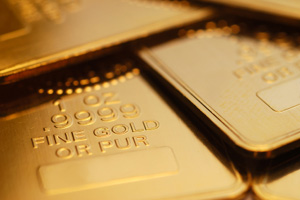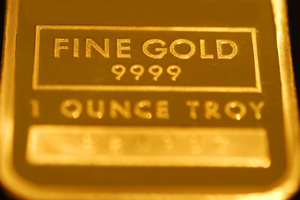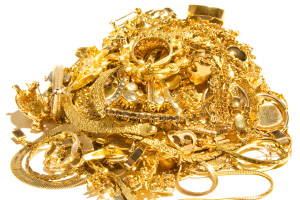 In its quest to determine the best way to make money from investing in gold, the Wall Street Journal recently took an in depth look at four different gold investment strategies. Each was represented by a preeminent investor, one whose method has seen some success recently.
In its quest to determine the best way to make money from investing in gold, the Wall Street Journal recently took an in depth look at four different gold investment strategies. Each was represented by a preeminent investor, one whose method has seen some success recently.
Here’s what they had to say:
1. The first investor was John Paulson, who made his money by anticipating the economic crisis and acting accordingly. His current method of gold investment is to buy shares of large mining and exploration companies. The idea at work here, according to Paulson, is that “if gold prices do well, the miners will do even better . . . the higher gold prices go, the more miners can profit from potential and existing projects.” The downside here is that mining for gold is an expensive proposition, so the miners must make enough money to cover that expense before turning a profit.
2. The next investor discussed was billionaire Thomas Kaplan. He is focusing his investment funds on junior miners rather than the big mining companies that Paulson is currently interested in. His argument? These smaller companies are “sitting on valuable assets . . . providing the greatest leverage to a bull market.” He believes that these junior miners have a greater potential to go along with their greater risk.
3. The third investor, John Burbank prefers a different route. He focuses his attention on gold bar investment. Since the bars are an actual physical investment, he believes that they are more likely to return his investment than shares and contracts. According to Burbank, “If investors become concerned that shares and futures contracts aren’t fully backed by physical gold, or if inflation surges, they may begin to demand delivery of the metal, sending the price of physical gold soaring.”
4. The final investor, David Einhorn is also interested in bars, but in addition, he chooses to invest in exchange trade funds that own gold miners. He has also purchased call options or gold futures, which require a relatively small investment to control a large gold position.
 A press release was distributed last week indicating the Aurion Resources Ltd has signed a binding letter of intent with Gammon Gold Inc. This letter of intent will ultimately give Gammon the option to earn up to a 70% interest in Aurion’s 100% owned La Bandera gold project in Durango Mexico.
A press release was distributed last week indicating the Aurion Resources Ltd has signed a binding letter of intent with Gammon Gold Inc. This letter of intent will ultimately give Gammon the option to earn up to a 70% interest in Aurion’s 100% owned La Bandera gold project in Durango Mexico.

 There’s a new exhibit in town at The Field Museum. This exhibit, arranged by the American Museum of Natural History, New York and the Huston Museum of Natural Science, Chicago, focuses on the sheer allure of this very precious metal. It is also the last stop on the exhibition’s tour.
There’s a new exhibit in town at The Field Museum. This exhibit, arranged by the American Museum of Natural History, New York and the Huston Museum of Natural Science, Chicago, focuses on the sheer allure of this very precious metal. It is also the last stop on the exhibition’s tour. China is the world’s second largest consumer of gold, so their interest in the metal is understandable. It is also the world’s largest producer of the metal. Still, the country is exhibiting a newly invigorated consumer and investor interest in the metal that is bound to capture some attention.
China is the world’s second largest consumer of gold, so their interest in the metal is understandable. It is also the world’s largest producer of the metal. Still, the country is exhibiting a newly invigorated consumer and investor interest in the metal that is bound to capture some attention. According to their recent statements, Newcrest Mining Ltd. is working to double gold production at their Bonikro mine on the Ivory Coast.
According to their recent statements, Newcrest Mining Ltd. is working to double gold production at their Bonikro mine on the Ivory Coast. In May of this year, the very first gold vending machine in the world was installed and used. That’s right, a vending machine where a customer can purchase gold bars was put into place. It’s located in Abu Dhabi’s Emirates Palace hotel—a luxurious place that is frequented by billionaires and even royalty—and apparently, it’s been a success. Gold to Go, the company that owns and operates the machine has recently announced that it has plans to consider a US installation.
In May of this year, the very first gold vending machine in the world was installed and used. That’s right, a vending machine where a customer can purchase gold bars was put into place. It’s located in Abu Dhabi’s Emirates Palace hotel—a luxurious place that is frequented by billionaires and even royalty—and apparently, it’s been a success. Gold to Go, the company that owns and operates the machine has recently announced that it has plans to consider a US installation. The industry that centers around recycling gold products like fillings or family jewelry is nothing new in countries like India, where the precious metal is an enduring part of the culture. There, everyone knows where they can buy and sell recycled gold in order to make a little money. In the US, however, things are different.
The industry that centers around recycling gold products like fillings or family jewelry is nothing new in countries like India, where the precious metal is an enduring part of the culture. There, everyone knows where they can buy and sell recycled gold in order to make a little money. In the US, however, things are different.